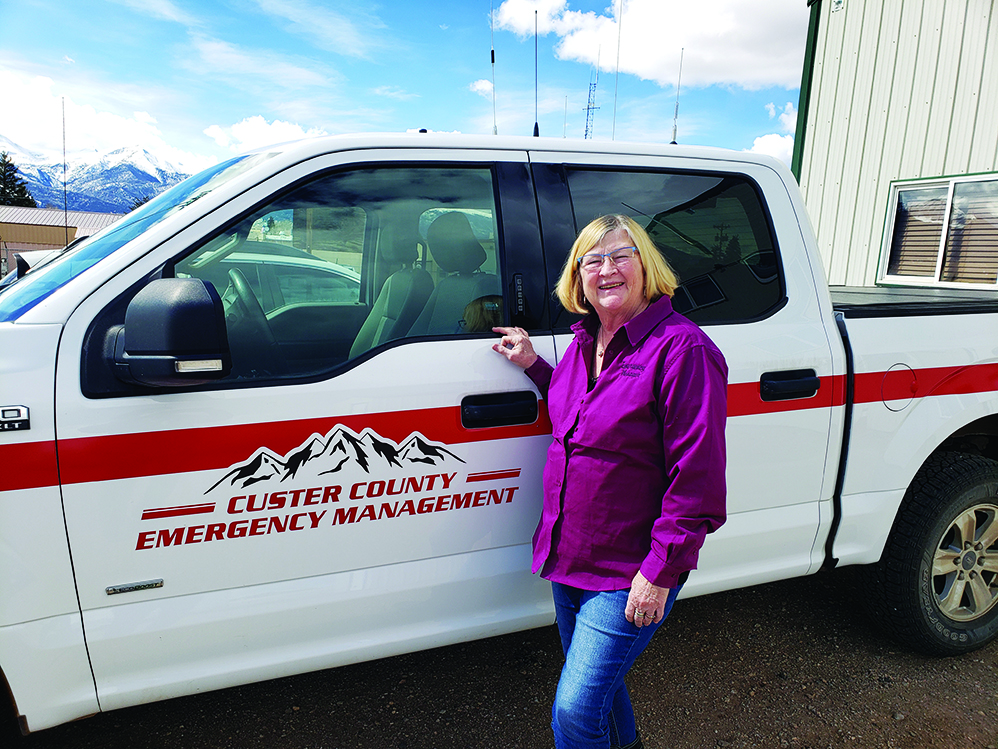– By Ellen Glover
This story was originally published on March 23, 2023
Custer County’s new emergency management officer, Robyn Knappe, feels right at home in the Valley. Her father’s ancestors were part of the German Colony that came to the area in the 1860s and farmed along Verdemont Road.
“I feel at home in Westcliffe. That’s why I am concerned that people learn how to protect themselves from the most obvious hazard we have here — wildfire,” she said.
Knappe has a deep understanding of all kinds of disasters through her work with the American Red Cross in Denver for 25 years as well as her work with the state government. She said the 2013 floods along the Front Range, when disaster emergencies were declared in 14 counties, were the most devasting. The flooding was caused by approximately 15 inches of rainfall over the span of a week, which killed eight people and caused $2 billion in damage.

Knappe said each county is responsible for maintaining an annual disaster plan, and her office, along with the Sheriff’s Office, is reviewing plans and resources for Custer County. She said there is strength in small communities that can be tapped in case of emergency and will be analyzing what is needed here. “Do we develop agreements with other towns for disaster assistance, or do we have contractors on retainer? Each county has to weigh its own plan and train people to react appropriately,” she explained.
The EMO officer said she learned from the 2013 floods that while it was good to have support from state and federal agencies, when that support left, it was up to the local communities and their volunteers to support the victims of the floods.
“I plan to reach out to faith-based groups and some of the volunteer organizations here to work with them,” she said. Knappe added that Custer County has an aging population that poses a problem for rescuers because many elderly people are not comfortable with technology, and notifications and warnings become more difficult. “It is hard to reach people when they are hesitant to sign up for online warnings. Go to our website at www.custercounty-co.gov/oem and sign up for calls in both Custer and Fremont Counties,” she explained. She also can be reached at 719-269-7952.

Knappe said people should familiarize themselves with creating a defensible space around their homes. She recommended people learn about Colorado State University’s Firewise USA program, which is a national recognition program that provides instructional resources to inform people how to adapt to living with wildfire and encourages neighbors to work together and take action to reduce their wildfire risk. (See https://csfs.colostate.edu/wildfire-mitigation/colorado-firewise-communities/)
The Colorado State Forest Service provides technical assistance and education to interested landowners, homeowners, and communities to help them take action and ownership in preparing their homes against the threat of wildfire.
Many hazards can be reduced to acceptable levels by following these fire-wise guidelines:
• Thin out continuous tree and brush cover to create a surrounding “defensible space” of at least 30-100 ft. Adequate thinning is reached in the defensible space when the outer edge of tree crowns is at least 10 to 12 feet apart. If your home is on a slope, enlarge the defensible space, especially on the downhill side.
• Dispose of all limbs and branches (slash) left from thinning by chipping or lop and scatter (cut debris into small pieces and scatter over the area to accelerate decomposition).
• Remove dead limbs, leaves, and other ground litter within the defensible space.
• Prune branches from trees within the defensible space to a height of 10 feet above the ground. Remove shrubs, small trees, or other potential “ladder” fuels from beneath large trees (left in place; ladder fuels can carry a ground fire into tree crowns).
• Make sure your roof is fire resistant, and screen roof and attic vents to prevent ember entry.
• Never store flammable materials underneath decks or porches. Remove dead vegetation and debris from under decks/porches and between deck board joints.

Knappe said more information is available at her office in the Search and Rescue building, and anyone is welcome to call for further information. She said that they had started a Citizens Emergency Response Team (CERT), and anyone could sign up to participate. They are now doing a “train the trainer” session, and classes will be available soon. She is anxious to get out a preparedness message and is offering to speak to homeowners associations or partner with the Forest Service for talks. Knappe said businesses also need to be prepared and order supplies ahead of the fire season.
“Emergency management is a ‘whole community’ effort. It touches every part of our community, whether that is medical, public health, law enforcement, or neighbor-to-neighbor. We are making sure that everything is accessible, including translating information if necessary. Sign up for the emergency alerts or classes, so everyone is ready for wildfire,” she concluded.
– Ellen Glover

